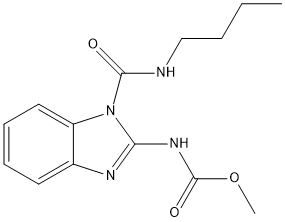Benomyl
Benomyl is a systemic agricultural fungicide used for control of certain fungal diseases of stone fruit.Benomyl binds to microtubules. No major toxic effects in mammals. It is not true cholinesterase inhibitor (LD50 of greater than 10,000 mg/kg/day for rats) Some cases of anophthalmia birth defects reported
General
Type : Carbamate,Fungicide,Imidazole,Benzimidazole
Chemical_Nomenclature : methyl N-[1-(butylcarbamoyl)benzimidazol-2-yl]carbamate
Canonical SMILES : CCCCNC(=O)N1C2=CC=CC=C2N=C1NC(=O)OC
InChI : InChI=1S\/C14H18N4O3\/c1-3-4-9-15-13(19)18-11-8-6-5-7-10(11)16-12(18)17-14(20)21-2\/h5-8H,3-4,9H2,1-2H3,(H,15,19)(H,16,17,20)
InChIKey : RIOXQFHNBCKOKP-UHFFFAOYSA-N
Other name(s) : [1-[Butylamino)carbonyl]-1H-benzimidazol-2-yl]carbamic acid methyl ester,1-(Butylcarbamoyl)-2-benzimidazolecarbamic acid methyl ester,Arilate,Uzgen,Arbortrine,Fungochrom,Benomyl-Imex,Benlate,Tersan 1991,Benlate(R),Agrocit,Benosan,Du Pont 1991,Fundazol,Benex,BBC
MW : 290.32
Formula : C14H18N4O3
CAS_number : 17804-35-2
PubChem : 28780
UniChem : RIOXQFHNBCKOKP-UHFFFAOYSA-N
IUPHAR :
Wikipedia : Benomyl

Target
References (10)
| Title : Oxidative liver DNA damage in rats treated with pesticide mixtures - Lodovici_1997_Toxicology_117_55 |
| Author(s) : Lodovici M , Casalini C , Briani C , Dolara P |
| Ref : Toxicology , 117 :55 , 1997 |
| Abstract : Lodovici_1997_Toxicology_117_55 |
| ESTHER : Lodovici_1997_Toxicology_117_55 |
| PubMedSearch : Lodovici_1997_Toxicology_117_55 |
| PubMedID: 9020199 |
| Title : Benomyl affects the microtubule cytoskeleton and the glutathione level of mammalian primary cultured hepatocytes - Urani_1995_Toxicol.Lett_76_135 |
| Author(s) : Urani C , Chiesara E , Galvani P , Marabini L , Santagostino A , Camatini M |
| Ref : Toxicol Lett , 76 :135 , 1995 |
| Abstract : Urani_1995_Toxicol.Lett_76_135 |
| ESTHER : Urani_1995_Toxicol.Lett_76_135 |
| PubMedSearch : Urani_1995_Toxicol.Lett_76_135 |
| PubMedID: 7725345 |
| Title : Genotoxicity assay of five pesticides and their mixtures in Saccharomyces cerevisiae D7 - Bianchi_1994_Mutat.Res_321_203 |
| Author(s) : Bianchi L , Zannoli A , Pizzala R , Stivala LA , Chiesara E |
| Ref : Mutat Res , 321 :203 , 1994 |
| Abstract : Bianchi_1994_Mutat.Res_321_203 |
| ESTHER : Bianchi_1994_Mutat.Res_321_203 |
| PubMedSearch : Bianchi_1994_Mutat.Res_321_203 |
| PubMedID: 7515158 |
| Title : Mixtures of benomyl, pirimiphos-methyl, dimethoate, diazinon and azinphos-methyl affect protein synthesis in HL-60 cells differently - Marinovich_1994_Toxicology_94_173 |
| Author(s) : Marinovich M , Guizzetti M , Galli CL |
| Ref : Toxicology , 94 :173 , 1994 |
| Abstract : Marinovich_1994_Toxicology_94_173 |
| ESTHER : Marinovich_1994_Toxicology_94_173 |
| PubMedSearch : Marinovich_1994_Toxicology_94_173 |
| PubMedID: 7801320 |
| Title : Increase of micronucleus frequency in cultured rat hepatocytes treated in vitro with benomyl and pirimiphos-methyl separately and in mixture - Piatti_1994_Mutat.Res_324_59 |
| Author(s) : Piatti E , Marabini L , Chiesara E |
| Ref : Mutat Res , 324 :59 , 1994 |
| Abstract : Piatti_1994_Mutat.Res_324_59 |
| ESTHER : Piatti_1994_Mutat.Res_324_59 |
| PubMedSearch : Piatti_1994_Mutat.Res_324_59 |
| PubMedID: 7515471 |
| Title : Effect of a mixture of 15 commonly used pesticides on DNA levels of 8- hydroxy-2-deoxyguanosine and xenobiotic metabolizing enzymes in rat liver - Lodovici_1994_J.Environ.Pathol.Toxicol.Oncol_13_163 |
| Author(s) : Lodovici M , Aiolli S , Monserrat C , Dolara P , Medica A , Di Simplicio P |
| Ref : J Environ Pathol Toxicol Oncol , 13 :163 , 1994 |
| Abstract : Lodovici_1994_J.Environ.Pathol.Toxicol.Oncol_13_163 |
| ESTHER : Lodovici_1994_J.Environ.Pathol.Toxicol.Oncol_13_163 |
| PubMedSearch : Lodovici_1994_J.Environ.Pathol.Toxicol.Oncol_13_163 |
| PubMedID: 7722883 |
| Title : Survey of imported green coffee beans for pesticide residues - Jacobs_1993_Food.Addit.Contam_10_575 |
| Author(s) : Jacobs RM , Yess NJ |
| Ref : Food Additives & Contaminants , 10 :575 , 1993 |
| Abstract : Jacobs_1993_Food.Addit.Contam_10_575 |
| ESTHER : Jacobs_1993_Food.Addit.Contam_10_575 |
| PubMedSearch : Jacobs_1993_Food.Addit.Contam_10_575 |
| PubMedID: 8224325 |
| Title : Safety\/risk assessment of pesticides: principles, procedures and examples - Lu_1992_Toxicol.Lett_64_783 |
| Author(s) : Lu FC , Dourson ML |
| Ref : Toxicol Lett , 64-65 :783 , 1992 |
| Abstract : Lu_1992_Toxicol.Lett_64_783 |
| ESTHER : Lu_1992_Toxicol.Lett_64_783 |
| PubMedSearch : Lu_1992_Toxicol.Lett_64_783 |
| PubMedID: 1471237 |
| Title : A rapid in vivo bioassay for the carcinogenicity of pesticides - Cabral_1991_Tumori_77_185 |
| Author(s) : Cabral R , Hoshiya T , Hakoi K , Hasegawa R , Fukushima S , Ito N |
| Ref : Tumori , 77 :185 , 1991 |
| Abstract : Cabral_1991_Tumori_77_185 |
| ESTHER : Cabral_1991_Tumori_77_185 |
| PubMedSearch : Cabral_1991_Tumori_77_185 |
| PubMedID: 1862543 |
| Title : [Radiometric determination of 11 carbamate pesticides in the nanogram and subnanongram ranges by means of cholinesterase inhibition] - Schmid_1977_Nahrung_21_311 |
| Author(s) : Schmid ER , Damboritz W , Markl P |
| Ref : Nahrung , 21 :311 , 1977 |
| Abstract : Schmid_1977_Nahrung_21_311 |
| ESTHER : Schmid_1977_Nahrung_21_311 |
| PubMedSearch : Schmid_1977_Nahrung_21_311 |
| PubMedID: 406567 |